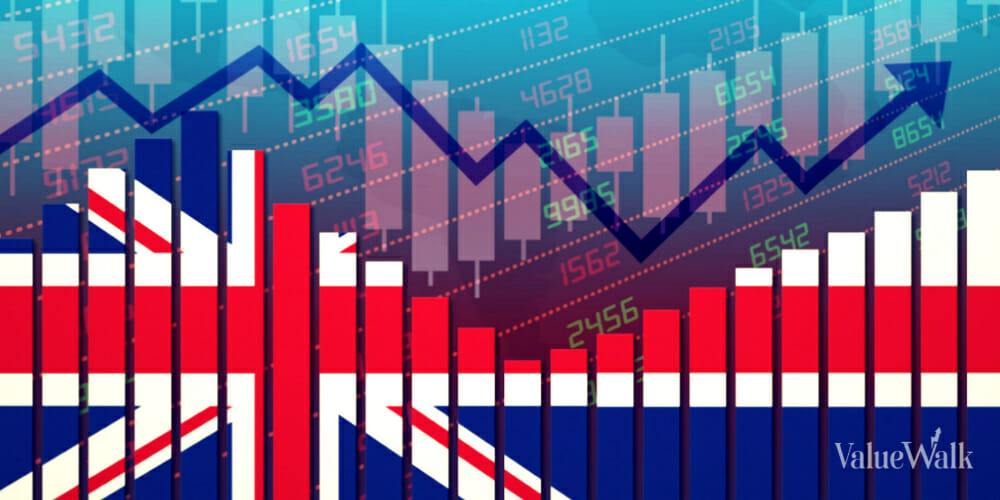There are a lot of UK dividend stocks compared to other markets. In the UK, there is a greater emphasis on value investing than on growth stocks, as a lot of investors prefer to earn income while they wait for price appreciation. The current average dividend payout on the FTSE 100 is 3.6%, compared to 1.32% on average on the S&P 500.
Sometimes, though, the highest dividend stocks UK are some of the riskiest investments. In many cases, the dividend yields of companies rise merely because the stock has plummeted due to negative financial news. The best dividend paying stocks in the UK, however, are those that combine above-average dividend yield with strong financials.
We have taken a look at the best UK dividend stocks based on several factors, such as track record of shareholder payouts, strong balance sheets and cash positions, and selected five top UK dividend stocks to buy right now.
Here’s a quick overview of our picks of the UK stocks that provide above-average passive income.
- Phoenix Group Holdings: In addition to operating some of the largest insurance companies in the UK, including Standard Life and SunLife, the London-based company has a large long-term savings and retirement business. The unit manages £283 billion of assets for 12 million customers. Its shares are up 1.54% in 2024.
- Greencoat UK Wind: The London company is the leading renewable infrastructure fund in the UK. It operates 49 wind farms in the country with a net generating capacity of 2,007 megawatts. Its shares are down 7.64% so far this year.
- HSBC Holdings: The London-based company is the largest bank in Europe, with total assets of more than $2.9 trillion. It traces its origins to the Hong Kong and Shanghai Banking Corporation, founded in 1869. To this day, it generates around two-thirds of its profits in Asia, with China being the main contributor. Its shares are up 8.42% in 2024.
- Aviva: The London-based insurer has more than 19 million customers. It’s the largest general insurer in the UK and the second-largest general insurer in Canada. Its shares are up more than 11% this year.
- IG Group: The trading platform, which began in 1974 in London as Investors Gold Index, offers stocks and shares ISAs, exchange-traded funds, bonds and margin trading. Its shares are up more than 11% in 2024.
Comparison of the top-ranked UK dividend stocks
Here’s a summary of the most promising UK dividend stocks to buy at the moment:
| Ticker on LSE | Company | Dividend Yield |
|---|---|---|
| PHNX | Phoenix Group Holdings | 9.77% |
| UKW | Greencoat UK Wind | 7.43% |
| HSBC | HSBC Holdings | 6.97% |
| AV | Aviva | 6.91% |
| IGG | IG Group | 5.41% |
An in-depth look at these top UK dividend stocks
Now let’s take a more detailed look at five well-performing companies that provide a dividend yield of at least 5%. These are some of the best long-term dividend stocks on the London Stock Exchange for income investors.
If you’re looking for dividend stocks outside of the UK, our experts regularly review other markets and suggest stocks for income investors elsewhere.
1. Phoenix Group Holdings: Average 10-year annualised return of 0.02%

Phoenix has been around for 240 years and operates the largest long-term savings and retirement business in the UK. Its growth is driven by the rise of pension risk transfers, as more and more companies turn over their pension management, and pension liabilities, to companies such as Phoenix Group. The stock dipped slightly recently when the company said it was considering selling off its SunLife financial services business. It said it wasn’t “core to the delivery of its vision of becoming the UK’s leading retirement savings and income business.” Phoenix bought SunLife’s financial services business from insurance giant AXA in 2016 as part of a £375 million ($482 million) deal. SunLife brought in a pre-tax profit of £16 million in 2023.
In fiscal 2023, Phoenix generated £2 billion of cash, beating its goal of £1.8 billion. The company also saw adjusted operating profit before tax of £617 million, up 13.4% over 2022.
The strong finances and cash generation allowed the company’s board to raise its dividend per share by 3.64% to 52.65 pence. Phoenix has increased its total annual dividend by 45% since 2010, including a bump up of 13.8% in the past five years. Considering the company said it expects 25% growth in operating cash generation by 2026, the dividend should continue to grow.
2. Greencoat UK Wind: Average 10-year annualised return of 2.52%

Greencoat UK Wind operates wind farms across England, Scotland, Wales and Northern Ireland, with 56% of them onshore and the rest offshore. It says that its goal is to give investors an annual dividend that increases in line with UK Retail Price Index (RPI), a measure of inflation, while preserving the capital value of its investment portfolio of UK wind farms. The UK investment trust is attractive to investors because of its green energy connection, and because it delivers an above-average dividend.
The company increased its target dividend to 10 pence this year, a 14.2% increase over the 2023 target dividend of 8.76 pence. The dividend is covered twice over, meaning it doesn’t need to dip into equity markets to fund the dividend.
With UK investment trusts, the value of their assets is known as a net asset value (NAV). Greencoat’s shares are trading for less than the current NAV, meaning they’re at a discount — a good opportunity for investors.
At the end of the first quarter of 2024, its net asset value (NAV) totalled 160p per share, a slight 0.4% decline from the start of the year. The NAV decline was due to lower-than-expected power generation, including an outage at the company’s Hornsea 1 facility, and lower wind speeds. The company generated net cash of 5.5 pence per share over the quarter. It also said it was continuing its £100 million buyback scheme with the purchase of 13.8 million shares in the quarter.
3. HSBC Holdings: Average 10-year annualised return of 0.49%

HSBC recently sold its interest in Canada and Argentina, in an effort to concentrate on its more profitable markets in the UK and Asia. HSBC is a big retail and commercial lender in Hong Kong, and it’s crucial in financing shipments across the globe. The bank has recently said it’s keeping its leadership in house, promoting CFO Georges Elhedery as its new CEO. He replaces Noel Quinn, who is retiring. Elhedery, who speaks Mandarin, represents the company’s pivot to focusing more on wealth management, particularly in Asia.
In the first quarter, the company had revenue of $20.8 billion, up 3% year over year, though profit before tax fell 1.5% to $12.7 billion. The relatively strong profits enabled HSBC to say it was returning $8.8 billion to shareholders. It will buy back $3 billion of its shares, and pay a first interim dividend of $0.10 per share, plus a special dividend of $0.21 per share relating to the sale of its Canadian assets.
The lender is on track for its fourth consecutive year of dividend growth. It’s trading at less than eight times earnings, representing good value. The payout ratio on its dividend is around 32%, meaning it’s sustainable. These factors make it a good long-term stock for value-oriented investors who are interested in dividends. There are concerns, though, about how the continuing slowdown in China will affect HSBC, and whether it can continue to maintain the record profits ($30 billion in 2023), once interest rates drop.
4. Aviva: Average 10-year annualised return of -3.11%

Aviva delivers insurance, wealth and retirement resources. While it has focused its business more on profitable markets, it continues to grow its diversified business through mergers and acquisitions. The Labour Party’s election victory in the UK may help Aviva’s growth, if it follows through on pension reform it had pledged. The insurer is also growing through acquisitions. So far this year, the company bought Canada’s Optiom O2 Holdings for £100 million, Bermuda-based Probitas, part of Lloyd’s, for £242 million and completed the acquisition of AIG’s UK protection business for £453 million.
The company is on track for its fourth consecutive year of dividend growth. It just issued an interim dividend of 22.3p, an increase of 7.7% over last year’s interim dividend. The dividend’s future growth looks strong, considering the company’s continued financial growth. Aviva’s has a £300 million share buyback program in place as well.
In the first quarter, several areas of Aviva’s business saw double-digit revenue growth. General insurance premiums grew 16% year over year to £2.7 billion. Retirement sales rose 13% to £1.7 billion and wealth grew 15% to £2.7 billion. Its smallest segment, protection and health, produced the slowest growth at 5%, to £106 million. The company’s share of the workplace pensions market expanded in the quarter, with £2 billion in new business, including 136 new schemes.
5. IG Group: Average 10-year annualised growth rate of 3.16%

IG Group has grown from a company that specialised in trading contracts for difference (CFD) to a broad-based investing platform. Throughout that time of growth, it has kept its core over-the-counter stock business while adding shares of more than 17,000 companies, including 3,925 in the UK. It also offers more than 2,000 exchange-traded funds (ETFs), and bonds.
Since 2020, annual revenue increased more than 50% and EPS has risen 22%. In the 2024 fiscal year ended 31 May, revenue declined 3% on the previous year to £987.3 million, dragged down by a 10% drop in trading revenue. Trading revenue fell to £844.9 million. A 76% jump in interest income helped mitigate the impact of lower trading revenue. The number of customers fell slightly to 346,200 from 358,300 the year before.
IG Group’s stock trades for less than 12 times earnings. The company, looking at what they see is an under-appreciated stock, has bought back more than 19 million shares since November, spending roughly £139.8 million. It said it will buy back £150 million of its shares by the end of January 2025.
IG has increased its dividend the past three years, including an increase by 1 pence to 46.2 pence per share for 2024. It’s well-covered with a payout ratio of around 49%.
What are dividend stocks?
Not all companies pay out dividends. Many growth-oriented companies, for example, prefer to reinvest most of their profits back into their business. Companies that do deliver dividends do so by paying out a portion of their profits to shareholders as dividends. These are sometimes called income stocks. A well-established market such as the UK tends to draw investors who are more conservative, with a larger base of older investors who are looking for regular income from their investments.
There are a few things to think about regarding dividend stocks.
Dividends can be paid in two ways. Companies pay their dividends in cash or in additional shares of a company’s stocks. Many European stocks deliver two dividends a year, an interim dividend and a year-end dividend. Some stocks, particularly those that trade on international exchanges, pay out a dividend on a quarterly basis.
Dividends are not guaranteed. Once a company generates profits through its operations, it usually gets approval from its board of directors whether to distribute a portion of its profits as dividends. When a dividend is declared, and the dividend amount per share is decided upon, a company then sets an ex-dividend date (the one by which an investor must own a stock to get the dividend) and then, the record date, the actual date the dividend is paid out.
Companies that have a long history of increasing their dividend gain status among income-oriented investors. Companies that increase their dividend payout for at least 25 consecutive years are called Dividend Aristocrats. Those that increase their dividend payout for 50 or more consecutive years are called Dividend Kings.
Pros and cons of dividend investing
There are advantages and disadvantages to investing in UK dividend stocks.
Some of the pros of buying UK dividend stocks:
Regular Income: This is a major attraction, particularly in the UK, which has a culture that is attracted to dividends. They can ensure you get regular payouts, which can be cruciall for retirees or those needing a steady income stream.
Focus on Stable Companies: Dividend-paying companies in the UK are often large-cap stocks, including all five that we selected. These established businesses have a long track record of profitability, providing stability and lower risk compared to stocks that either don’t provide a dividend, have a lower dividend yield, or those that rarely increase their dividends.
Compounding is important: If you reinvest your dividends, you can benefit from compounding growth. As your dividends grow, so do the dividends you earn on those reinvested amounts.
There are tax advantages: In the UK, you get a tax-free allowance on the first £500 of dividend income each year. This reduces your tax burden on a portion of your dividends. In addition, dividends are taxed at lower rates than income from your salary, unless you are in the highest tax bracket.
Reduced growth potential: Dividend-paying companies often prioritise returning profits to shareholders through dividends rather than reinvesting heavily for future growth. This can limit their capital appreciation compared to high-growth stocks.
Reduced diversification: The top dividend paying stocks in the UK tend to be connected to banks, insurance, and utilities. An overemphasis on higher dividend stocks could reduce an investor’s portfolio diversity, potentially leading to a greater risk.
High yields may mask issues: A high dividend yield can be tempting, but it’s not the only factor. Companies may prioritise maintaining high dividends even if it’s unsustainable or a sign of underlying financial issues.
Dividend cuts are possible: Dividends aren’t guaranteed. Even established companies can cut dividends if they face financial difficulties. This can negatively impact your income stream and potentially the stock price.
Methodology: Choosing the best UK dividend stocks
We were on the hunt for UK stocks with above-average dividend yields that, based on a company’s consistent cash flows, were sustainable. The five dividend stocks we chose are all large companies with steady growth potential to make sure their dividends are safe.
Learn more about our methodology here
We consider a wide range of factors before choosing the best dividend stocks for UK investors. We take into account the following:
- Dividend yield and payout. Because we were looking for the top dividend-paying stocks in the UK, we focused on those that had yields of at least 5%. However, we also looked for those whose payout ratios were sustainable, based on consistent cash flows.
- Stock performance. We looked at companies that have shown the ability to continue to grow revenue and earnings, as revenue growth is critical to maintaining the share price and a high dividend.
- Earnings growth. We examine how consistent the company has been in generating year-over-year earnings growth. Ideally, we are looking for stocks that generate double-digit annual earnings growth on an annual basis over a multi-year period.
- Reasonable Valuations. It’s important to buy a stock that is fairly priced given its potential. We looked at companies that had price-to-earnings ratios that weren’t higher than the average in their particular sector.
- Market Share. It is important to consider how dominant the company is in its given market or markets. Is this company a leader in its market? Is it among the leaders in multiple markets? Many of the top stocks, like Amazon, for example, are leaders in multiple markets. Market leaders are generally going to have strong earnings power. Also, is the company gaining, or losing, market share?
- Competitive Advantages. A key to a company’s enduring success is its competitive advantages. We look at whether the stock has advantages over its competitors, whether its scale, pricing power, a product or service that is best-in-class. We judge whether it has a moat that makes its advantages hard to overcome for rivals.
- Growth Catalyst. In addition, it’s important to look for other growth catalysts that could spur the stock higher. Did it expand into new markets through an acquisition? Are there new or pending regulations that could help or hinder the company? Are there new products coming, are there changes in the industry? These are just some examples.
- Capital/Financial Strength. The foundation upon which a company can grow is its financial or capital strength. We look to see if it has a significant, and growing, amount of operating cash or free cash flow, because that will allow it to invest in its future growth or navigate downturns. Also, we look to see if its debt is reasonable so that a disproportionate amount of earnings isn’t going to pay down debt.
- Analysts’ Estimates. While we don’t solely rely on what Wall Street analysts think of a company or stock, we certainly gauge their consensus recommendations and price targets in determining the best stocks.
- Efficiency. Another key consideration is how efficient the company is in turning a profit. While all industries are different, the operating margins and profit margins will give you a sense of how much a company is spending to generate profit. Higher, and rising, margins mean the company is operating more efficiently.











